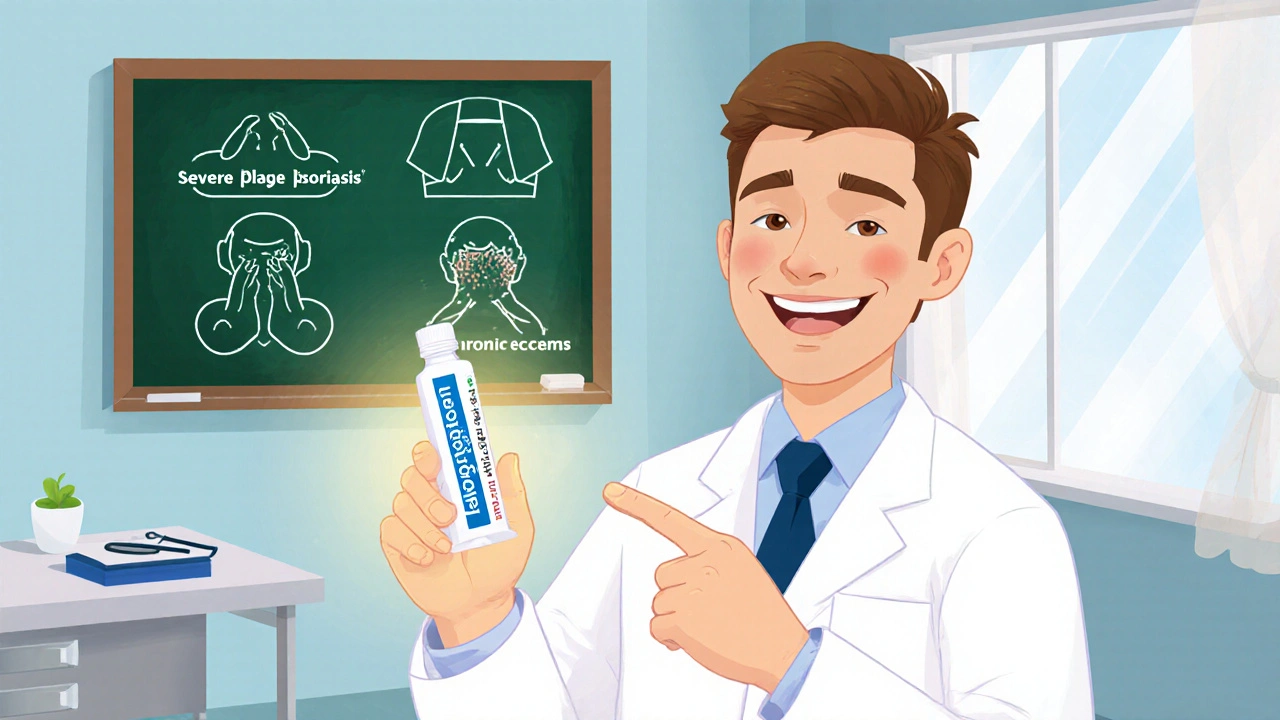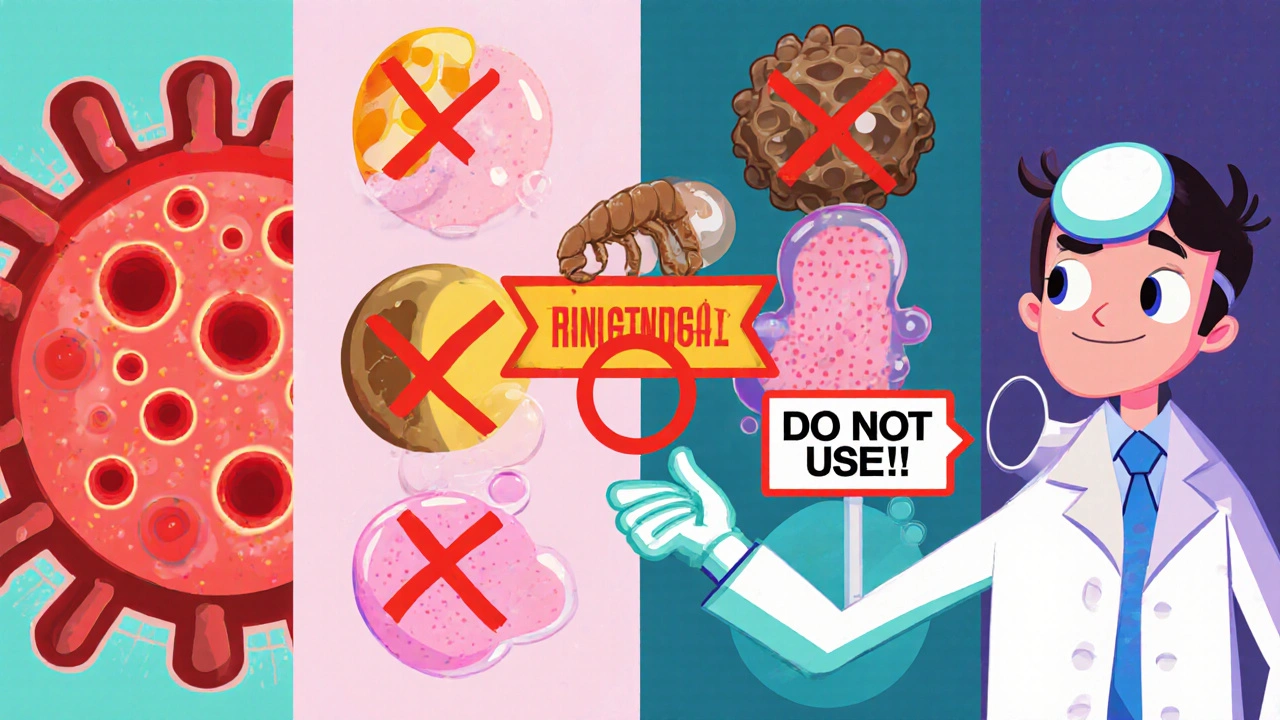 Oct, 17 2025
Oct, 17 2025
Halobetasol Contraindications Checker
Patient Assessment
Result
When prescribing topical steroids, Halobetasol is a super‑high‑potency corticosteroid used for skin conditions like psoriasis and eczema. Yet, not everyone can use it safely. This guide walks you through the exact situations where halobetasol should be avoided, why those warnings exist, and how to protect patients who need strong anti‑inflammatory treatment.
What is Halobetasol?
Halobetasol halobetasol propionate belongs to the corticosteroid a class of steroid hormones that reduce inflammation and suppress immune responses family. It’s marketed as a 0.05% cream, ointment, or spray and is considered a Class I (super‑potent) topical steroid in the United Kingdom. Its primary role is to calm severe plaque psoriasis, chronic eczema, and other inflammatory dermatoses that haven’t responded to milder therapies.
How Halobetasol Works
The drug penetrates the stratum corneum and binds to glucocorticoid receptors in skin cells. This triggers a cascade that decreases production of prostaglandins, leukotrienes, and cytokines-molecules that drive redness, itching, and swelling. Because the molecule is so potent, even a thin layer can produce dramatic symptom relief, but it also raises the risk of systemic absorption and local skin damage when misused.
Key Contraindications - When Not to Use Halobetasol
A contraindication means the drug should never be applied because the risk outweighs any benefit. Below are the absolute contraindications recognized by dermatology guidelines and the UK Medicines and Healthcare products Regulatory Agency (MHRA).
- Viral skin infections such as herpes simplex, varicella‑zoster, or molluscum contagiosum. Steroids suppress local immunity, letting the virus spread.
- Fungal infections (tinea corporis, candida). Suppression of the immune response can turn a mild infection into a deep, treatment‑resistant one.
- Untreated bacterial infections (impetigo, cellulitis). Halobetasol can mask symptoms and allow the bacteria to proliferate.
- Rosacea and acne vulgaris. High‑potency steroids trigger rebound flares and worsen these conditions.
- Periorificial areas (face, eyelids, genitalia) when the formulation is not specifically approved for those sites. The skin there is thin, leading to rapid atrophy.
Who Should Avoid Halobetasol? - Relative Contraindications
These are situations where halobetasol can be used only with extreme caution, a short course, or under close monitoring.
- Pregnancy and lactation. The drug crosses the placenta and appears in breast milk in trace amounts. Although data are limited, most clinicians avoid super‑potent steroids on large body areas during the first trimester.
- Children under 12 years. Their skin absorbs more drug per unit area, increasing the chance of systemic effects such as growth suppression.
- Elderly patients. Age‑related skin thinning raises the risk of atrophy, striae, and telangiectasia.
- Patients on systemic CYP3A4 inhibitors (e.g., ketoconazole, erythromycin). These drugs slow the metabolism of halobetasol, potentially raising systemic exposure.
- Individuals with known hypersensitivity to halobetasol or any formulation excipient. An allergic reaction may manifest as itching, swelling, or a rash.

Special Populations - Detailed Look
Each group has distinct considerations that influence prescribing decisions.
Pregnancy
The FDA classifies halobetasol as Category C (risk cannot be ruled out). In the UK, the British National Formulary advises using the lowest‑potency steroid needed for the shortest time. If treatment is essential, limit application to no more than 5% of body surface area and avoid the face and intertriginous zones.
Children
Child skin can absorb up to three times more drug than adult skin. A 2‑year‑old with extensive eczema may develop hypothalamic‑pituitary‑adrenal (HPA) axis suppression after just a few weeks of daily use. Regular monitoring of morning cortisol levels is recommended if treatment exceeds two weeks.
Elderly
Skin elasticity declines with age, making it prone to striae, bruising, and delayed wound healing. A 70‑year‑old with plaque psoriasis should start with a thin layer once daily for three days, then reassess.
Patients on CYP3A4 Inhibitors
Drugs like ketoconazole or erythromycin inhibit the liver enzyme that metabolizes many steroids. If a patient is already taking such medication, reduce halobetasol frequency to every other day and watch for systemic signs like fatigue or unexplained weight gain.
Common Side Effects vs. Contraindications
Understanding the difference helps clinicians decide when a symptom is a red flag versus an expected, manageable effect.
- Local skin atrophy - Thinning of the dermis. This is a side effect that can become a contraindication if severe.
- Telangiectasia - Visible tiny blood vessels. Usually reversible if the steroid is stopped.
- Striae (stretch marks) - Appear after weeks of high‑potency use on large areas; avoid by limiting treatment area.
- Systemic HPA‑axis suppression - Rare with topical use, but possible in children or with occlusion. Check morning cortisol if suspected.
Managing Risks - Practical Tips for Safe Use
- Confirm diagnosis - Ensure the condition truly needs a super‑potent steroid. Try medium‑potency options first.
- Limit surface area - Apply to no more than 10% of body surface area at any given time.
- Short‑course therapy - Typical regimen: once‑daily for 2‑3 weeks, then a taper or switch to a lower‑potency steroid.
- Avoid occlusion unless specifically prescribed. Plastic wraps can double systemic absorption.
- Educate patients - Explain how much to use (a pea‑size amount for each fingertip‑length area) and the dangers of “just a little more”.
- Monitor vulnerable groups - Schedule follow‑up visits for children, pregnant women, and the elderly to check skin integrity and systemic signs.

Comparison with Other Super‑Potent Steroids
| Aspect | Halobetasol (0.05%) | Clobetasol (0.05%) |
|---|---|---|
| Potency rank | Super‑high (Class I) | Super‑high (Class I) |
| Systemic absorption (average % of dose) | ≈0.5% (higher on thick plaques) | ≈0.3% |
| Common contraindications | Viral/fungal infections, pregnancy, children < 12 | Same plus known hypersensitivity to clobetasol |
| Incidence of skin atrophy (per 100 patients) | 4‑5 | 3‑4 |
| Approved for scalp | No (off‑label only) | Yes (foam formulation) |
Both drugs share most red‑flags, but halobetasol tends to stay longer in the skin, which can be a double‑edged sword for stubborn plaques.
Frequently Asked Questions
Frequently Asked Questions
Can I use halobetasol on my face?
Generally no. The facial skin is thin, so a super‑potent steroid can cause rapid atrophy, telangiectasia, and steroid‑induced rosacea. Only a specially formulated low‑dose version should be considered, and even then for the shortest time possible.
What should I do if a viral infection appears under the cream?
Stop halobetasol immediately and start an antiviral regimen (e.g., acyclovir for herpes). Once the infection clears, you can reassess whether a lower‑potency steroid is safe.
Is it safe to combine halobetasol with a moisturiser?
Yes, applying a bland moisturiser after the steroid has absorbed (5‑10minutes) can reduce dryness and improve barrier function. Avoid moisturisers that contain alcohol or fragrances, as they can irritate the skin.
How long can a child safely use halobetasol?
Never exceed two weeks of continuous use on any body part. Ideally, limit treatment to a small flare, then switch to a mid‑potency steroid for maintenance. Check morning cortisol if therapy extends beyond this window.
Does halobetasol interact with oral steroids?
The interaction is minimal because halobetasol’s systemic absorption is low. However, combined systemic exposure can increase the risk of HPA‑axis suppression, so clinicians usually avoid overlapping high‑dose oral steroids and prolonged topical use.
By respecting the contraindications and following the safety checklist above, clinicians can harness halobetasol’s powerful anti‑inflammatory punch while keeping patients out of trouble. Remember: the drug works best when used sparingly, for a short burst, and under close supervision.
Carissa Padilha
October 17, 2025 AT 03:20Ever wonder why the pharma giants push super‑potent steroids like halobetasol without a warning label that says "do not use on kids"? They want us dependent on a cycle of quick fixes while they sit on the sidelines collecting data. The real danger is hidden in the fine print-systemic absorption that can mess with your adrenal glands. It's not just about skin atrophy; it's about a covert experiment on everyday users. Keep an eye on the ingredients and question the motives behind the hype.
Alexis Howard
October 17, 2025 AT 14:20yeah i think they overhype it its just a cream nothing fancy but people act like it''s miracle i dont see the point
Darryl Gates
October 18, 2025 AT 04:13Great rundown! The step‑by‑step guidance really helps clinicians feel confident when prescribing this high‑potency option. Remember to start with the smallest amount and monitor for side effects-it's a classic coach approach. If a patient shows early signs of atrophy, taper down quickly and switch to a milder steroid. Keep up the thorough work, it makes a big difference in patient safety.
Sara Werb
October 18, 2025 AT 18:06Can u believe they even let this monster cream near our faces?!? The skin on the cheek is sooo thin and this thing will turn it into a wasteland!!! I swear if they don’t label it properly they’re playing with our lives!!!
Winston Bar
October 19, 2025 AT 08:00Honestly, this whole halobetasol hype feels like a marketing stunt designed to keep us hooked on yet another overpriced product. They brag about its "super‑high potency" as if stronger automatically means better, ignoring the countless stories of people who end up with shredded skin. I’ve seen patients who thought a few weeks would be harmless, only to develop ghostly white patches that never fully healed. The contraindications listed are just a checklist for the pharmaceutical lobby to tick off after the fact. Viral infections? Sure, they’d rather you treat the virus with antivirals than admit a steroid made it worse. Fungal eruptions get masked, and you end up with a stubborn infection that spreads like wildfire. Bacterial boils? You might miss early signs because the cream masks the redness and pain. Then there’s the whole pregnancy nightmare-why shove a Category C drug onto a pregnant woman’s skin when safer options exist? Kids under twelve are especially vulnerable; their bodies absorb three times more, yet the label whispers "use with caution" like a suggestion. Elderly patients with thin skin become walking scar factories if you’re not careful. And let’s not forget the CYP3A4 inhibitors that turn a topical into a systemic bomb-who thought that was a good idea? The more you dig, the clearer it becomes that this isn’t about patient care, it’s about profit margins. I’d advise anyone reading this to question every "must‑have" claim and demand a real risk‑benefit analysis before slathering on any super‑potent steroid. Bottom line: look beyond the glossy brochure and protect your skin the smart way.
Russell Abelido
October 19, 2025 AT 21:53I hear the concerns about systemic absorption and it resonates with the broader idea that we often treat symptoms without seeing the whole person. 🌱 When a cream penetrates deeper than we expect, it reminds us that every intervention has ripples beyond the surface. Think of the skin as a frontier-what we apply there can echo in the body’s hormonal orchestra. Staying mindful, we can balance relief with respect for the body’s natural harmony. Let’s keep the dialogue open and learn from each case.
Steve Holmes
October 20, 2025 AT 11:46Interesting points, especially regarding the short‑course recommendations, and it's worth noting that patient education plays a crucial role, too; many users simply don't know how much "pea‑size" actually is, which leads to over‑application. Moreover, combining topical steroids with moisturizers can improve barrier function, yet the timing of application matters-allow the steroid to absorb first, then follow with a bland moisturizer. Lastly, monitoring for early signs of atrophy, like subtle thinning, is essential, because catching it early can prevent long‑term damage.
Tom Green
October 21, 2025 AT 01:40When guiding a new prescriber, I always stress the importance of limiting the treatment area and duration, as these are the pillars of safe halobetasol use. It’s also helpful to schedule a follow‑up after two weeks to assess skin response and adjust the plan accordingly.
Emily Rankin
October 21, 2025 AT 15:33Picture the skin as a canvas that occasionally needs a bold brushstroke, yet we must never forget that the masterpiece endures only when each stroke is deliberate. Halobetasol can be that bold brush, but using it wisely transforms a flare into a fleeting moment, not a permanent scar. Stay hopeful, stay informed, and your patients will thank you for the care you provide.
Roberta Makaravage
October 22, 2025 AT 05:26Fact: halobetasol’s systemic absorption rates are higher than most clinicians assume, and that fact alone warrants a more cautious approach. 🌟 Ignoring this can lead to unnecessary endocrine disruption, which is ethically unacceptable. 📚
Lauren Sproule
October 22, 2025 AT 19:20Hey there i think the guide does a good job at breaking down the risks and i appreciate the clear language. just a heads up dont forget to check for allergies before starting treatment
CHIRAG AGARWAL
October 23, 2025 AT 09:13Man this article is way too long i could've read the TL;DR in a minute but whatever they needed to put all that info
genevieve gaudet
October 23, 2025 AT 23:06In many cultures skin health is tied to identity, so using a super‑potent steroid without understanding its deeper effects can feel like a loss of self. It's a reminder to respect traditions while embracing modern medicine.
Patricia Echegaray
October 24, 2025 AT 13:00The pharma machines want us to swallow their "miracle cream" like obedient consumers, but we must see through the glossy propaganda. Our skin is our first flag, and protecting it from corporate overreach is a patriotic act. Choose wisely, question the narrative, and keep the battle for true health alive.
Samantha Oldrid
October 25, 2025 AT 02:53Oh sure, because slathering on a super‑potent steroid is the answer to every skin problem.
Malia Rivera
October 25, 2025 AT 16:46In the grand scheme, halobetasol is just another tool in the arsenal, but wielded without wisdom it becomes a weapon against our own well‑being. Let’s keep the conversation grounded and not fall for hype.